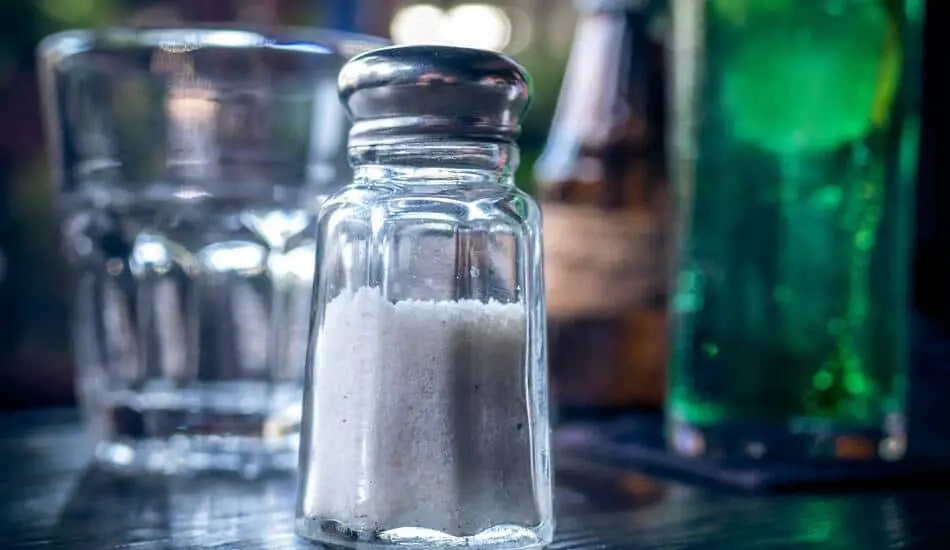The sourness in sourdough bread primarily comes from lactic fermentation by the naturally present lactic acid bacteria found in flour that produces lactic acid and acetic acid; lactic acid provides a smooth sourness akin to yogurt while acetic acid provides a sour bite akin to vinegar.
There is a lot happening during the fermentation process and if we can better understand it, we can better control the sourness of our starter and of the baked loaf.
There are three types of fermentation reaction in sourdough bread

When water is added to flour, the flour hydrates and fermentation begins. There are 3 distinct types of fermentation reaction that takes place in a sourdough bread. All 3 fermentation reaction consumes the simple sugars that is produced by the naturally present amylase enzymes from consuming the starches in the flour. It is the acidic byproducts of lactic fermentation that contributes to the sourness of sourdough bread.
- Alcohol Fermentation by Yeast
Simple sugar —> Ethanol + CO2
Yeast found in naturally leavened sourdough breads are single celled fungi that feed on simple sugars and requires oxygen to reproduce. When the oxygen is depleted, yeast undergo anaerobic fermentation reaction by consuming simple sugars to give off ethanol (alcohol), and carbon dioxide.
Both ethanol and carbon dioxide that is dissolved in the liquid dough makes the sourdough starter slightly acidic and contributes to the sourness of the sourdough starter. However, when the loaf is baked in the oven, all the ethanol and carbon dioxide is evaporated and they do not contribute to the sourness of the baked loaf.
- Lactic fermentation by Homofermentative Lactic Acid Bacteria
Simple sugar —> Lactic Acid
Homofermentative bacteria converts simple sugars into lactic acid. The lactic acid stays in the sourdough starter and the baked loaf which contributes greatly to the sourness of both the starter and the finished loaf.
Young sourdough cultures only have homofermentative bacterias that produces lactic acid.
Common homofermentative lactic acid bacteria strains found in sourdough bread includes:
- Lactobacillus acidophilus
- L. casei
- L. plantarum
- L. Delbrueckii
- Lactic fermentation by Heterofermentative Lactic Acid Bacteria
Simple sugar —> Lactic Acid + Acetic Acid + CO2
Heterofermentative bacteria converts simple sugars into lactic acid, acetic acid and carbon dioxide. While the carbon dioxide evaporates during baking, both the lactic acid and acetic acid stays in the loaf after the bake and contributes greatly to the sourness of both the starter and the finished loaf.
Older sourdough cultures have both homofermentative and heterofermentative bacterias that provides a balance in sourness profile between the lactic acid and acetic acid that is present.
The lactic acid bacteria strain responsible for the heterofermentative reaction is different than the lactic acid bacteria strain responsible for homofermentative reaction.
- Lactobacillus sanfranciscensis
- L. brevis
- L. Fermentum
The benefits of sourness in sourdough bread
The sourness in sourdough bread comes from the acidity of the byproducts of the lactic fermentation reactions; as the acidity in the mix increases, its sourness increases as well. It is this acidity and sourness in sourdough bread that makes it superior to regular yeast leavened bread.
The acidity in sourdough bread gives rise to many benefits:
- Contributes flavor
Organic acids give bread a delicate flavor, pleasing aromatic tang and a long finish.
- Preserves flavor by reducing mixing time
The acidity helps to tighten and strengthen the dough structure, therefore less mixing is required to achieve the desired dough strength. The less time we spend mixing the dough, the less oxygen we incorporate into it, oxidation of carotenoid pigments are minimized which preserves the wheaty aroma and delicate flavor of the baked loaf.
- Improves nutritional value
Acidity of sourdough activates phytase enzymes which eliminates the effects of phytic acid. Phytic acid is found in the bran coating of cereal grains, which interferes with the body’s ability to absorb calcium, zinc, iron, magnesium and copper. Acidity in sourdough promotes absorption of these nutrients into the body by eliminating the effects of phytic acid.
- Improves keeping quality
Acidity lowers the pH value of the loaf, which naturally protects it from decomposing microorganisms and delays the effects of staling.
- Inhibits starch attack in Rye bread
Starch attack happens in Rye bread when the amylase enzymes are overly active, which converts too much of the structural starches in the crumb into the non structural simple sugars. When this happens, the resulting baked loaf will have a gummy crumb. The acidity in sourdough starters slows down the metabolism of the amylase enzymes and keeps starch attack at bay.
The downsides of excessive sourness in sourdough bread
Although the acidity in sourdough breads is very beneficial to our bake, there are times when we would want to reduce the sourness as too much of it can pose a problem.
Some people enjoy the light sourness in sourdough bread, while others don’t care for it.
When the sourdough is too sour, it can overly tighten the dough structure and inhibit a full rise.
10 Ways to adjust the sourness of your sourdough bread

1. Time and temperature of fermentation
A longer fermentation at a higher temperature increases the production of acids by the lactic acid bacteria.
Fermentation happens throughout the baking process. It happens during the bulk fermentation phase after mixing, during the bench resting phase, during the final proofing phase, and even during the initial baking phase when the loaf is loaded into the oven. We can control the time and temperature of any of these phases in the baking process to achieve the desired sourness of our baked loaf.
To increase the sourness of our bake, we can increase the time and temperature of our fermentation.
To decrease the sourness of our bake, we can decrease the time and temperature of our fermentation.
2. Amount of water used
The development of lactic acid favors a warm and loose dough, while acetic acid favors a cool and stiff dough; you can control the temperature and hydration of the sourdough culture to achieve the desired sourness profile.
A balance of lactic and acetic acid is desirable in sourdough as lactic acid provides smoothness (akin to yogurt) while acetic acid provides a sour bite (akin to vinegar).
We can increase the smooth sourness in our sourdough bread by increasing the temperature and hydration of the dough.
We can increase the sour bite in our sourdough bread by reducing the temperature and hydration of the dough.
3. Amount of pre-ferment used
A pre-ferment is essentially the ripe sourdough starter that has been built up to a desired weight which will be added to the final dough mix; it contains a lot of the acids that makes sourdough sour.
To decrease the sourness of our bake, we can increase the amount of pre-ferment used in the final dough. Since organic acid develops quite slowly, using a higher percentage of pre-ferment results in a dough that completes the fermentation phase in a shorter time with fewer organic acids produced.
To increase the sourness of our bake, we can decrease the amount of pre-ferment used. With a lower percentage of pre-ferment, the dough is able to be fermented for a longer period, allowing the dough to fully develop in acidity.
This technique of using a low percentage of pre-ferment (8-10% of total weight of flour) with a long fermentation time is seen in the baking of very wet dough such as the Pan De Cristal sourdough bread; the low percentage of pre-ferment used allows the acids to develop fully over the long fermentation time that gives these very wet and weak dough its strength.
4. Using whole grain flour
Whole grain flour contains all parts of the kernel to include the bran, endosperm and germ while white flour only contains the endosperm. Whole grain flour like whole wheat or whole rye flour has more microorganisms present for the fermentation reaction and thus produces more acidity.
To increase the sourness of the bake, use whole grain flour and to decrease the sourness of the bake use white flour.
5. Folding and degassing during bulk fermentation
If you find that your sourdough is not sour enough and that it has a poor rise, then perhaps there is an excessive amount of carbon dioxide in the dough that can impair the fermentation reaction. Degassing is usually done during folding, by pressing down on the dough during the bulk fermentation phase to expel carbon dioxide gasses to prevent an excessive build up.
It is a good idea to degas the dough at least once every hour of bulk fermentation to ensure fermentation is not impaired and for the acidity to fully develop.
When folding and degassing, be mindful that each fold adds strength to the dough and over folding can strengthen the dough too much and restricting the dough from achieving a full rise. For most sourdough breads, 1 to 2 folds is sufficient as the acidity from the pre-ferment also helps to strengthen the dough. 1 fold consists of the folding of all four sides of the dough into its centre.

6. Using Salt
Salt is an incredibly important ingredient in sourdough bread. One of the effects of salt is that it slows down the fermentation reaction. The more salt we use, the slower the fermentation reaction and the less acidity and sourness we will get from our baked loaf.
Sourdough starter does not typically call for the inclusion of salt, however some bakers use the salt-sour method where a proportion of the overall dough salt is used in the sourdough starter phase. This slows down sourdough yeast activity and reduce acid production which allows the sourdough to be used 48 hours after initial mixing.
We can increase sourness of our bake by reducing the amount salt used, and we can decrease the sourness of our bake by increasing the amount of salt used. Most formulas calls for salt in the range of 1.5-2.5% of total weight of flour.
7. Avoid using tap water
Avoid using tap water for the creation of sourdough starter as the chlorine in tap water inhibits the metabolism of the developing microorganisms and hence killing the yeast and bacteria that we need for the fermentation reaction.
If you find that your sourdough is not sour enough, check to see if the water you are using is chlorinated. A simple way to dechlorinate water is to leave water out over night for all the chlorine to dissipate; boiling the water does not remove chlorine. Alternatively you can purchase bottled mineral water when baking sourdough bread.
8. Using sugar
When too much sugar is used (more than 10% baker’s percentages), it reduces fermentation activity.
Sugar is hygroscopic (it attracts water), it draws water that would otherwise be used by the yeast and bacteria to undergo fermentation. A larger quantity of sourdough starter/pre-ferment is typically used in high sugar formulation doughs to offset the negative effects of sugar on the fermentation reaction. Milk and honey are commonly found ingredients in a sourdough formulation that increases its sugar content.
When baking a high sugar formulation bread and you find that your sourdough is not sour enough, using more yeast or pre-ferment can help counteract the negative effect of sugar on the fermentation rate.
9. Using the hooch
A common way to increase sourness of your bake is to use the hooch of the sourdough starter. The hooch is the liquid that collects on the top of your starter when it hasn’t been fed for a while; the hooch is the alcoholic byproducts of yeast fermentation and is acidic in nature.
The danger of using the hooch is that if you do not decrease the amount of water that is called for in the formulation, you will be increasing the hydration of the dough as the hooch is liquid and can change the overall hydration formulation of the recipe.
Another problem with using the hooch is that you have to account for its temperature when determining the water temperature to arrive at the desired dough temperature at the end of the mix.
10. Using baking soda
Some bakers use baking soda to reduce the sourness of sourdough bread as baking soda is alkaline by nature and neutralizes the acidic elements in sourdough. However using too much baking soda puts you at risk of a collapsed loaf, a bitter taste and a dirty brown color when baked.
Conclusion
The sourness in sourdough bread comes from the lactic acid and acetic acid produced during lactic fermentation. The sourness indicates the degree of acidity of the sourdough, and it is this acidity that brings about the characteristic tanginess and full wheaty aroma of the sourdough bread.
However, we would want to avoid sourdough that is too acidic. An overly sour taste can be unpleasant and a highly acidic sourdough could inhibit the loaf’s rise as the acidity tightens the gluten structure excessively.
We can control the production of acid by these lactic acid bacteria to achieve the desired sourness in our sourdough bread. Some of the most important factors that can affect the rate of lactic fermentation are the ingredients (amount of water, salt, sugar and type of flour) used in the bake, the time and temperature of fermentation as well as degassing the dough.

